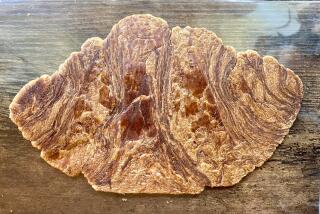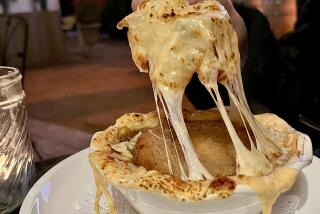When in Paris, do as the Parisians do — eat pastries
The next time you’re in Paris, drop your concern about carbs and surrender to sugar. The jewelry-like pastries these top-tier tastemakers turn out make it worth putting aside your intestinal fortitude for a bit of heaven.
Pierre Hermé: In this chic shop on Rue Bonaparte in the St-Germain-des-Prés neighborhood, a serious discussion is taking place between a well-dressed Frenchwoman in her mid-40s and the store clerk. The salesperson is inquiring about what cuisine and wines the hostess will be serving, the purpose of the occasion and even the dress code.
After gathering all the information he deems necessary, the merchant makes his recommendations. The hostess affirms his choices with a brief nod and, with gloved hands, he removes a selection of macarons from their place in the case and places them gently in a round box with orange piping that says simply, “Pierre Hermé.”
Panorama: 360-degree view from the Eiffel Tower
Pierre Hermé is one of several famous patisseries in Paris that have become well known for their macarons — a delicate cream-filled cookie with a crisp outer shell. Part of what has made these macarons so popular, despite their price tag of about $2.50 each, is the unusual flavor combinations, such as Arabesque, with apricot and pistachio; Mogador, made from passion fruit and milk chocolate; and Magnifique, a combination of strawberry and wasabi.
One of the top pastry chefs in Paris, Pierre Hermé has managed to marry the dense taste of an exotic cake with the light crunch of a sugar cookie — creating nothing short of a macaron movement.
Café Lenôtre: David Lebovitz, an American food blogger and cookbook author living in Paris, said the French take a boutique approach to pastry. “There is not a huge selection, and things are not created to be cheap, but rather to be multilayered works of art,” said Lebovitz. “French pastries are more refined than American. You may have a mousse, a ganache, a jelly and a fruit all in one pastry.”
Nowhere is this architectural approach to pastry more apparent than at ultra-chic Café Lenôtre. The beautiful display of desserts that greets patrons upon entering any one of the nine locations throughout the city includes a Saint-Honoré cake with raspberry macarons encircling a whipped strawberry cream that conceals a strawberry compote, and a cerise sur le bonbon made from chocolate biscuits layered with chocolate mousse and cherries and swathed in chocolate molded to look like a piece of candy.
These sugary sculptures live up to their promise with tastes that are as complex as their looks. The only problem? They’re so pretty that, even at about $6 a pastry, you almost hate to eat them.
Gérard Mulot: “You can diet in your own country,” Françoise Renauldon said as she handed over a chocolate and basil muffin. The astringent basil did a fox trot on my tongue with the dark but not-too-sweet chocolate enrobed in a rich yellow cake.
Madame Renauldon is the friendly manager of Gérard Mulot, a patisserie near the apartment my husband and I rented for a week in the Marais district. We came to think of her as a pastry enabler. Every morning, as we made our way past the shop, she smiled and waved us in to have a morning treat.
The smell of fresh-baked croissants, combined with the enticing window displays featuring all manner of luscious-looking treats, rendered us helpless. Over the course of a few days, we consumed a muffin made with pistachio and cherries; a croissant aux amandes topped with crystallized sugar and smoky-flavored toasted almonds; and a tarte Tatin, whose crunchy pastry with honey, butter and caramelized sugar overtones left me speechless.
The day we left, Renauldon insisted we try a traditional French brioche sucrée as our parting pastry. More bread than cake, the yeasty, chewy interior was balanced by the slightly sweet sugar crystals on its crust. As we polished off the last bit of brioche, we said goodbye to our local pastry shop, but the sweet memory of a week eating pastry in Paris has remained.
More to Read
Sign up for The Wild
We’ll help you find the best places to hike, bike and run, as well as the perfect silent spots for meditation and yoga.
You may occasionally receive promotional content from the Los Angeles Times.






